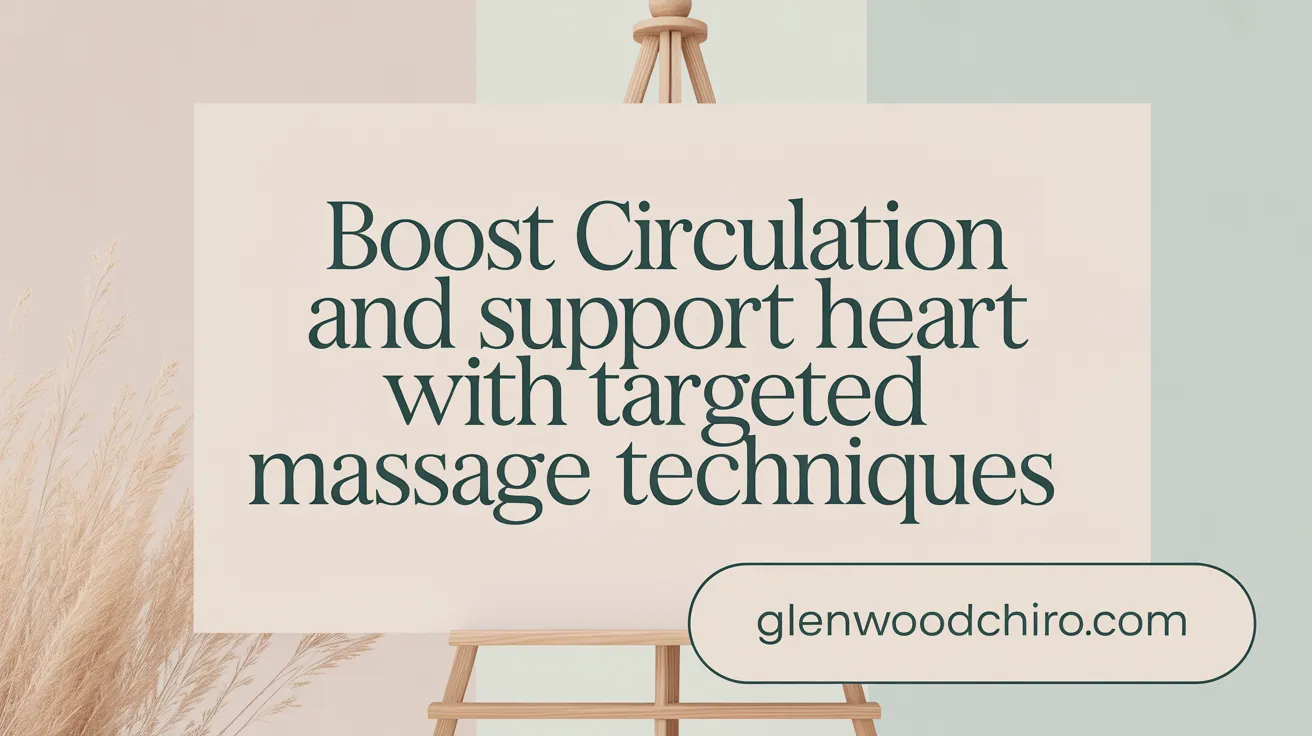Understanding the Multifaceted Benefits of Massage Therapy
Massage therapy is celebrated not only as a source of relaxation but also as a powerful therapeutic tool that enhances physical health. By stimulating circulation, promoting muscular stability, and accelerating recovery processes, massage offers comprehensive support for body and mind. This article explores the science-backed benefits of massage therapy, detailing how various techniques contribute to improved blood flow, muscle balance, and faster healing, ultimately fostering overall wellness.
Enhancing Circulation for Cardiovascular and Tissue Health
 Massage therapy significantly benefits the body's circulatory system by stimulating blood and lymphatic flow. Techniques like effleurage, wringing, and lymphatic drainage are used to improve circulation through different mechanisms.
Massage therapy significantly benefits the body's circulatory system by stimulating blood and lymphatic flow. Techniques like effleurage, wringing, and lymphatic drainage are used to improve circulation through different mechanisms.
Effleurage involves gentle, gliding strokes that activate receptors causing vasodilation, which expands blood vessels and increases blood flow. This process helps deliver more oxygen and nutrients to muscles and tissues, supporting faster healing and reducing muscle stiffness. Wringing, a technique that involves twisting and squeezing muscles, helps loosen tight muscles, relieve tension, and promote the removal of metabolic wastes. This not only reduces soreness but also enhances the movement of blood and lymphatic fluids.
Lymphatic drainage is a specialized technique that accelerates the removal of excess fluids and toxins from tissues. By stimulating the lymphatic system, this method decreases swelling and alleviates associated pain, which is crucial during injury recovery or swelling management.
The physiological effects of massage on circulation go beyond just muscle relaxation. Increased vasodilation and capillarisation—the formation of new small blood vessels—improve nutrient delivery at the cellular level. Additionally, massage promotes venous return, helping blood flow back to the heart more efficiently. This comprehensive enhancement supports overall cardiovascular health and helps manage conditions like hypertension.
Regular massage may also boost cardiovascular resilience by improving heart rate variability and encouraging a relaxation response. Through reducing stress hormones such as cortisol and increasing relaxation hormones like serotonin and dopamine, massage therapy lowers blood pressure and decreases the heart's workload.
In summary, massage techniques that foster circulation not only improve tissue health and facilitate healing but also contribute to better cardiovascular function by optimizing blood flow, reducing inflammation, and supporting a balanced nervous system.
| Technique | Primary Effect | Additional Benefits |
|---|---|---|
| Effleurage | Stimulates vasodilation and blood flow | Promotes relaxation and reduces blood pressure |
| Wringing | Loosens muscles, relieves tension | Enhances metabolic waste removal |
| Lymphatic Drainage | Speeds up removal of excess fluids | Decreases swelling and boosts immune function |
This combination of massage methods creates a holistic approach to enhancing circulation, supporting cardiovascular health, and promoting overall tissue vitality.
Targeted Techniques to Boost Blood and Lymphatic Flow

Effleurage and its effects on vasodilation
Effleurage is a gentle, gliding massage technique that stimulates receptors in the skin. This action encourages vasodilation, which is the widening of blood vessels. As a result, blood flow increases, delivering more oxygen and nutrients to tissues while helping to reduce blood pressure. This technique is particularly effective for promoting overall circulation and soothing tense muscles.
Wringing technique benefits
Wringing involves grasping the muscle tissue and twisting or squeezing it to loosen tight muscles. This method helps relieve muscle tension, break down adhesions, and promote the movement of metabolic wastes from tissues. Enhanced waste removal helps reduce soreness and improves flexibility, aiding in quicker recovery after physical activity.
Lymphatic drainage and swelling reduction
Lymphatic drainage uses specific, gentle rhythmic movements to stimulate the lymphatic system. This technique accelerates the removal of excess fluids and toxins, significantly reducing swelling and pain. It is especially beneficial after injury or surgery, supporting the body's natural detoxification and healing processes.
Sports massage, Swedish massage, and remedial massage roles
Different massage styles contribute uniquely to improving circulation. Sports massage targets athletes by enhancing performance and accelerating recovery. Swedish massage employs long, flowing strokes like effleurage to boost blood flow and relax muscles. Remedial massage focuses on treating specific muscular issues, helping to break down scar tissue and restore normal movement. All these techniques play vital roles in maintaining healthy circulation and supporting overall recovery.
Massage Therapy’s Role in Accelerating Recovery
In what ways does massage therapy contribute to faster recovery after physical activity or injury?
Massage therapy plays a vital role in speeding up recovery by improving various physiological functions. One of its main benefits is increasing blood flow and oxygen delivery to damaged tissues. This enhanced circulation helps tissues heal more quickly by providing the necessary nutrients and removing metabolic waste products such as lactic acid, which can cause muscle soreness.
Reducing inflammation and muscle tension is another critical aspect. Techniques such as effleurage and deep tissue massage help loosen tight muscles and decrease swelling, alleviating discomfort often associated with injuries or intense workouts.
Massage also supports the removal of toxins accumulated in tissues. Specific methods like lymphatic drainage accelerate the clearance of excess fluids and toxins, reducing swelling and pain. This process not only promotes healing but also restores normal tissue function.
The activation of the parasympathetic nervous system is a physiological effect of massage that induces relaxation. By lowering stress hormones like cortisol and increasing relaxation hormones like serotonin and dopamine, massage improves mental well-being, which is crucial for physical recovery.
In relation to soreness, massage effectively manages delayed onset muscle soreness (DOMS). It alleviates stiffness and soreness by promoting circulation and reducing muscle tightness. This, combined with work on scar tissue, enhances joint mobility and extends the range of motion, aiding faster physical rehabilitation.
Overall, massage therapy offers a comprehensive approach to recovery. It addresses both physical and psychological factors, creating an environment conducive to quick healing. The benefits extend from improved circulation and toxin removal to relaxation and pain relief, all of which facilitate a faster return to optimal activity levels.
Additional Insights
| Technique | Primary Function | Effects on Recovery | Details |
|---|---|---|---|
| Effleurage | Stimulates receptors causing vasodilation | Increases blood flow, reduces blood pressure | Promotes circulation, enhances nutrient delivery |
| Wringing | Loosens muscles, relieves tension | Promotes waste removal, relaxes muscles | Loosens tight tissues, reduces stiffness |
| Lymphatic drainage | Speeds toxin and fluid removal | Reduces swelling, alleviates pain | Facilitates detoxification, relieves edema |
| Deep tissue massage | Breaks down scar tissue | Improves joint mobility, reduces pain | Enhances tissue elasticity, restores range of motion |
Through the combined use of these techniques, massage therapy helps in faster healing, injury prevention, and improving overall physical health.
Promoting Stability and Muscle Balance Through Therapeutic Massage

How does massage therapy enhance stability and muscle balance?
Massage therapy plays a vital role in improving muscle stability and balance by affecting how muscles function and coordinate. Through its physiological effects, massage influences several cellular and muscular processes that support muscle health.
One of the primary ways massage helps is by promoting proper protein turnover and activating satellite cells, which are essential for muscle repair and regeneration. This process ensures that muscles recover effectively from stress and injury, maintaining their strength and flexibility.
Furthermore, massage improves postural stability and proprioception—the body's ability to sense its position and movement. Techniques such as muscle relaxation, tension release, and addressing postural misalignments help enhance nervous system communication.
Research indicates that in older adults, massage can decrease balance displacement and improve control, which are critical factors in preventing falls.
When combined with targeted exercises and sensory stimulation, therapeutic massage supports restoring muscular equilibrium. This combination helps prevent injuries, reduces imbalance, and promotes overall coordination.
By supporting these biological and neural mechanisms, massage therapy fosters a more stable, balanced musculoskeletal system, essential for everyday function and athletic performance.
The Science Behind Massage Modalities and Their Healing Mechanisms

What scientific explanations and massage modalities promote improved circulation, stability, and healing?
Massage therapy employs various techniques and modalities that foster improved circulation, stability, and healing through multiple physiological and neurological mechanisms. These mechanisms include mechanical stimulation of tissues, neural activation, hormonal responses, and physical alterations in tissue properties.
One of the primary ways massage enhances circulation is through mechanical techniques like effleurage, wringing, and lymphatic drainage. Effleurage, involving gentle stroking movements, stimulates skin receptors that cause vasodilation — the widening of blood vessels — which increases blood flow to the targeted area. This not only supplies oxygen and nutrients but also accelerates the removal of metabolic wastes. Wringing techniques help loosen tight muscles and promote the flow of lymphatic fluids, further aiding in detoxification and swelling reduction.
Different massage styles contribute uniquely to physiological stability. For example, sports, Swedish, and remedial massages incorporate specific techniques such as deep tissue kneading or hydrotherapy (like HydroMassage™ with water jets) designed to increase tissue temperature, thereby improving muscle compliance and joint mobility. These techniques help break down scar tissue, reduce stiffness, and support tissue regeneration.
Neurological mechanisms also play a role, with massage activating the parasympathetic nervous system — the branch responsible for relaxation and recovery. This activation leads to a decrease in stress hormones like cortisol and an increase in relaxation hormones such as serotonin and dopamine. The hormonal shift fosters not only emotional wellbeing but also physical healing by reducing inflammation and pain.
Physiological changes include increased capillarization — the formation of new tiny blood vessels — enhancing tissue perfusion. Massage also increases muscle compliance, which improves joint range of motion and reduces stiffness. These effects are supported by the mechanical pressure applied during massage, which can elevate arteriolar pressure and muscle temperature, further facilitating blood flow.
Techniques like hydrotherapy utilize water jets to invigorate blood circulation and reduce inflammation effectively. Deep tissue and trigger point therapies target adhesions and muscle tightness, accelerating recovery and reducing pain. Additionally, massage impacts neural excitability, modulating the Hoffman reflex (a measure of neural activity), which contributes to improved muscular function.
In summary, massage techniques support healing by mechanically stimulating tissues, activating neural pathways for relaxation, reducing stress hormones, and promoting beneficial physiological changes like increased blood flow, tissue oxygenation, and tissue compliance. These combined effects explain how massage modalities enhance circulation, stability, and repair processes in the body.
| Technique/Modality | Main Effect | Additional Benefits |
|---|---|---|
| Effleurage | Vasodilation, increased blood flow | Stimulates receptors, promotes healing |
| Wringing | Loosens muscles, stimulates lymphatic flow | Detoxifies tissues, relieves tension |
| Lymphatic drainage | Accelerates removal of fluids and toxins | Reduces swelling, improves immune response |
| Hydrotherapy (HydroMassage™) | Improves circulation, reduces inflammation | Enhances lymph flow, relaxes muscles |
| Deep tissue massage | Breaks down scar tissue, increases compliance | Supports faster recovery, enhances flexibility |
Understanding these mechanisms highlights how diverse massage approaches work synergistically to improve overall health, aid recovery, and promote long-term stability in musculoskeletal function.
Comprehensive Health and Wellness Benefits from Regular Massage Therapy
What are the overall health and wellness benefits of massage therapy related to circulation, stability, and recovery?
Massage therapy provides a wide range of health benefits, especially by improving circulation, stability, and recovery processes. One of its primary effects is enhancing blood flow and lymphatic flow, which increases the delivery of oxygen and essential nutrients to tissues. This boost helps reduce inflammation, decrease pain, and speed up healing of injuries.
In addition, massage therapy promotes better muscle stability and flexibility. Techniques such as effleurage, wringing, and lymphatic drainage help loosen tight muscles, break down adhesions, and promote joint mobility. This not only improves range of motion but also makes muscles less prone to injury.
Furthermore, massage supports faster recovery after exercise or injuries. By increasing circulation and reducing muscle tension, it accelerates removal of metabolic wastes and diminishes soreness. These effects make it an effective tool for athletes and anyone recovering from physical strain.
Beyond physical benefits, massage therapy also boosts mental well-being. It can decrease stress hormones such as cortisol and increase relaxation hormones like serotonin and dopamine. This hormonal balance helps reduce anxiety, improve mood, and promote better sleep.
Together, these effects foster overall physical stability and quicker recovery. A consistent massage routine can strengthen the body's natural healing processes, improve mobility, and enhance both physical and mental health, contributing to a greater sense of well-being.
Massage Therapy’s Impact on Athletic Performance and Injury Prevention
What are the benefits of massage between athletic events?
Massage between athletic events can significantly support recovery by boosting blood circulation, which delivers oxygen and nutrients to muscles. This process helps reduce muscle soreness, stiffness, and fatigue, preparing athletes for their next activity.
In addition, massage promotes relaxation and releases endorphins, which improve mood and reduce stress levels. Techniques like hydroMassage™, involving water jets, further stimulate blood flow, lessen inflammation, and enhance joint mobility and muscle flexibility, contributing to overall quicker recovery.
How does massage help in reducing injury risk and muscle soreness?
Massage aids in breaking down scar tissue and loosening tight muscles, which can lessen the risk of injuries like strains or sprains. It improves joint mobility and increases range of motion, reducing the chance of musculoskeletal issues.
Furthermore, post-exercise massage has been shown to lower muscle soreness severity by promoting blood circulation and removing metabolic wastes. This accelerates healing, prevents chronic muscle tightness, and supports physical stability.
What are the limitations of scientific evidence on pre-exercise massage?
While many athletes believe pre-exercise massage enhances performance and reduces injury risk, scientific studies provide limited and inconclusive evidence for these claims. The precise mechanisms and benefits of pre-exercise massage are still not fully understood.
Research indicates that the effects of massage on performance or injury prevention depend on factors like the type of massage, timing, and individual responses. More rigorous studies are necessary to determine definitive benefits.
How does massage prepare athletes for subsequent performance?
Massage can enhance circulation, decrease muscle stiffness, and improve joint mobility, all of which facilitate better movement and muscle function. These effects can help athletes feel more prepared and less prone to injuries during subsequent activities.
Additionally, massage reduces stress hormones and reassures the nervous system, promoting a relaxed mental state that may support better concentration and effort.
What are the benefits of HydroMassage™ and other hydrotherapy modalities?
HydroMassage™ uses water jets to stimulate circulation and promote relaxation. It effectively reduces inflammation, enhances joint mobility, and increases muscle flexibility, making it particularly effective for recovery after intense workouts.
Hydrotherapy modalities like water jets and aquatic massages support faster healing by combining mechanical and thermal effects, which help in reducing muscle soreness, alleviating joint stiffness, and improving overall mobility.
| Technique | Benefits | Specific Effects |
|---|---|---|
| Effleurage | Stimulates vasodilation, increases blood flow | Decreases blood pressure, promotes circulation |
| Wringing | Loosens muscles, relieves tension | Promotes waste removal, relieves tightness |
| Lymphatic Drainage | Speeds up removal of toxins and excess fluids | Reduces swelling, pain, improves immune response |
Overall, massage therapy plays a vital role in enhancing circulation, reducing soreness, and supporting recovery and injury prevention in athletic contexts.
Neurochemical and Psychological Effects of Massage
Massage therapy has profound benefits beyond physical relief, extending into neurochemical and emotional well-being. One notable effect is the release of neurotransmitters such as serotonin, dopamine, and endorphins. These chemicals are associated with feelings of happiness, relaxation, and pain relief, contributing to an overall sense of well-being.
At the same time, massage helps decrease stress hormones, particularly cortisol. Lower cortisol levels reduce feelings of anxiety and tension, creating a calming effect that can last well after the session ends.
This combination of hormonal changes supports improvements in mood and a significant reduction in anxiety. Many individuals find massage to be a valuable tool for managing stress and enhancing emotional stability.
Additionally, massage promotes better sleep quality. When stress hormones decrease and relaxation hormones increase, it becomes easier to fall asleep and stay asleep, fostering emotional balance and physical recovery.
Overall, massage can be seen as part of a holistic approach to wellness, offering physical, mental, and emotional benefits. It encourages relaxation, reduces anxiety, and boosts mood, making it a vital complement to healthy living routines.
Embracing Massage Therapy for Enhanced Health and Recovery
Massage therapy serves as a multifaceted approach to improving physical health by enhancing circulation, promoting muscle stability, and accelerating recovery from activity and injury. Backed by scientific mechanisms, it not only supports cardiovascular wellness and musculoskeletal balance but also fosters mental and emotional well-being. Whether utilized in clinical, athletic, or wellness settings, regular massage treatments can optimize bodily functions, reduce stress, and aid healing processes, offering comprehensive benefits that extend beyond muscles and tissues to holistic health improvement.
References
- Improved Circulation - Benefits Of Massage
- Massage Therapy
- Benefits of massage therapy
- 15 Incredible Benefits of Massages: Reducing Stress, ...
- The Benefits of Massage Therapy - In Rochester
- The mechanisms of massage and effects on performance ...
- Benefits of massage therapy
- 15 Incredible Benefits of Massages: Reducing Stress, ...
- The Impact of Massage Therapy on Function in Pain ...
- The mechanisms of massage and effects on performance ...
